


From Baxter's 1891 history of Grand Rapids.
Left click on the images below for larger versions.
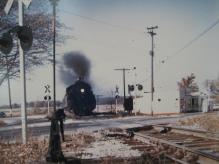
|
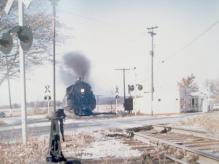
|
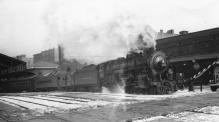
Union Station - 1949 Train to Jackson |
Left click on the image below for a larger version.
The photograph above shows the track in 1975, in a view looking southeast from the northwest corner of 44th and Kalamazoo. By 1984 the right of way would be abandoned and and the track torn up, and probably sold for the scrap value.
Left click on the images below for larger versions.
Left click on the images below for larger versions.

Kirkland Street. |

Kirkland Street looking north. |
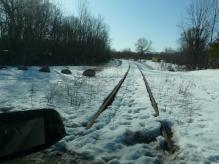
Kirkland Street looking southeast. |
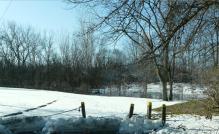
Plaster Creek Family Park. |
Left click on the images below for larger versions.

Approaching Buchanan crossing, going south. |
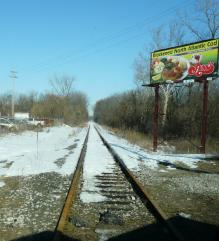
Buchanan crossing, looking northwest. |
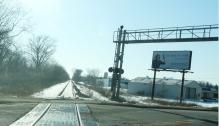
Buchanan crossing, looking southeast. |
Left click on the image below for a large version.
Material provided for scanning by John Kamstra, a local collector.
An aerial photograph from the 1940s, shows growth of Caledonia along both sides of the railroad track on which it mostly depended for it's existence. The track is well maintained. It provided those in Caledonia a way to get to Grand Rapids and back before the day when the automobile became more numerous.Left click on the images below for larger versions.
Material provided for scanning by John Kamstra, a local collector.
The images above show the central depot in Caledonia in about 1900. It's like the views are looking towards Grand Rapids. The boxcars are marked Michigan Central.Left click on the images below for larger versions.

|
Left click on the image below for a larger version.
A tribute to the success of the campaign is evidenced by the fact that by 1914 there was already a fish hatchery in Grand Rapids. The concept of fishing at that time, and before, was to go out for a day or more and catch every fish possible, small, large, and in between. It was not impossible for a couple of anglers to catch 300 fish in one day. Whether most were eaten is not clear. Similarly, hunting meant killing everything in site, possibly for a week or so. Old photos show piles of dead animals of every kind, and that was mostly the purpose of the event. There was no concept of seasons, so objects of the hunter's wrath could replenish their numbers, and as a result, some were literally driven to extinction. The classic example is the passenger pigeon. Others are at least locally extinct.
Left click on the image below for a larger version.
As the replica of a GR & I fishing badge shows, a major business for the line was the promotion of tourism and "sports." Sports being the slaughter any wildlife that could be found.
The line eventually continued on north of Grand Rapids to the Straights of Michigan, where train ferries carried the trains across the water to the Upper Peninsula, for many hundreds of miles. At its peak, the GR & IN was the longest north-south railroad corridor in the US. The track in the UP are long and straight, perhaps used mostly for the hauling of copper and other ores.Left click on the image below for a large version.
The GR & IN train shed was shared with the Grand River Valley Railroad. The GR & IN and GRVRR tracks diverged just north of 28th Street, with the GR & IN tracks heading straight south, and the GRVRR tracks heading straight southeast.
As of year 2008 the track is still active south of Grand Rapids, but not very. Track north of Grand Rapids has been abandoned, and 92 miles of it is now part of a state walking and bike path. Fred Meijer's has offered to provide money for it's development and upkeep, and of course expects it will be renamed the Fred Meijer's walking and bike path.
Left click on the images below for larger versions.

Union Depot in background. c1901 to 1910. Grocery on the corrner of Oakes & Ionia |
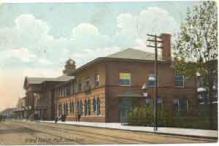
Postcard - about 1910. |
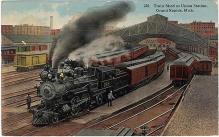
Postcard - about 1910. |
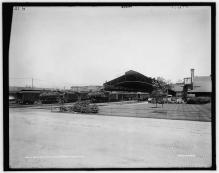
About 1905. |
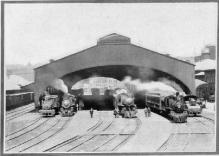
About 1910. |

Union Depot waiting room - undated |
Many Godwin students remember the "Flyers," as high speed passenger trains with limited stops were often called. Pulled by steam engines as late as the mid-1940s, they were not often seen by the mid-1950s.
Left click on any image below for a larger version.
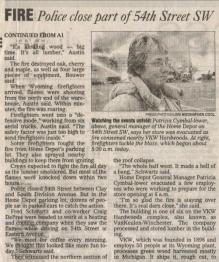
|
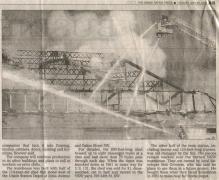
|
|
++++++++++++++++++++++++++ |
++++++++++++++++++++++++++ |
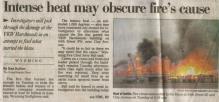
|
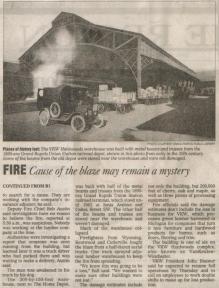
|
Apparently 114 years old, the old Union Depot shed was finally destroyed by a fire as large amounts of wood being stored under the shed burned. The metal structure was too badly deformed to subsequently be used for anything other than scrap.
The bulk of the Grand Rapids and Indiana Railroad - GR&I RR - system was mostly located in Indian and Ohio, but in 1870 a track was completed to Grand Rapids. The track runs along the west side of the GM stamping plant, where it crosses 36th Street. Many Godwin students would remember crossing the track when going and coming from school, and not a few would walk along the track for a ways. At one time the track ran all the way to where the Mackinaw Bridge exists today, where a train ferry would take trains to and from the upper peninsula. The track then continued a great distance in to the upper peninsula. Starting in Cincinnati, at one time the track was the longest north-south track in the US. In year 2007 most of the track north of Grand Rapids has been abandoned, much of it being turned in to a walking path. In the Upper Peninsula, most of the GR & I tracks still exist, but are at best lightly used. They supported tourist, copper and other mining activities, those activities are at a low ebb in year 2012. GR & I executives apparently did well, and a number of large mansions were erected on East Fulton in and around 1900. Most survive in year 2012, but long ago were turned in to dorms, apartments, and whatever else one does with a used mansion.
In the early 1920s the track was purchased by the Pennsylvania RR. In year
2007 the track is still active south of Grand Rapids. But the passenger trains
and large freight trains of 60 and more years ago are now but a memory.
Left click on the images below for larger versions.
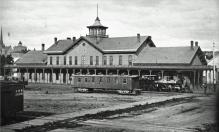
c1890 |
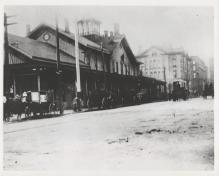
c1890 |
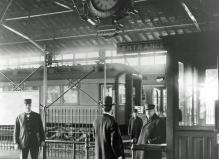
|
Left click on the images below for larger versions.
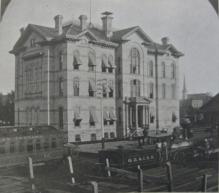
Undated. |
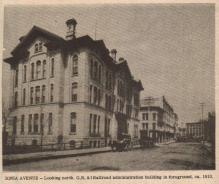
Circa 1910 |
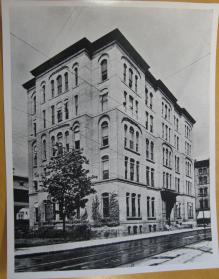
After 1910 - two stories added. |
Left click on the images below for a larger version.
Material supplied for scanning by Lillian Annis, class of 1941
The drawing or postcard image above is from 1891, and one can see the GR & I RR train shed, and the administration building to the left.
Left click on the images below for larger versions.

Looking along Century Ave. Undated. |
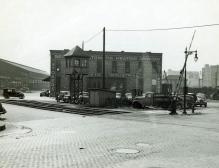
Circa 1920. |
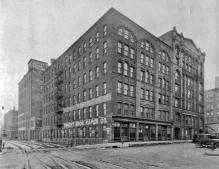
Circa 1920. |
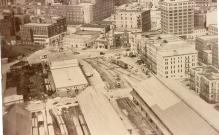
Circa 1950. |
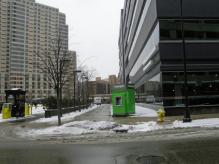
2013 |
Left click on the images below for larger versions.
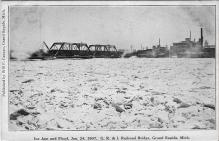
GR & I bridge - 1907 - ice jam. |

GR & I bridge - 1907 - ice jam. |
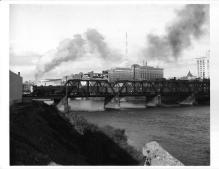
GR & I bridge - c1945 |

1969 |

2012 |
Left click on the images below for larger versions.
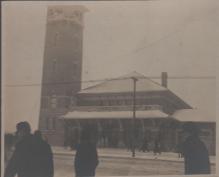
1906 |
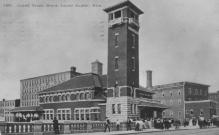
1906 |
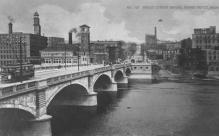
1906 |
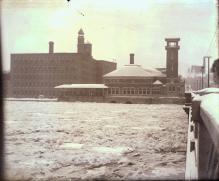
1908 - from a negative. |

1910 |
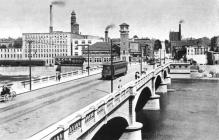
c1910 |
Left click on the images below for larger versions.
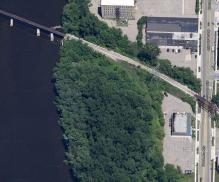
|
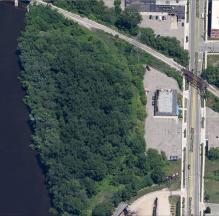
|

|

|

|
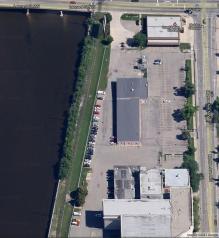
|

|
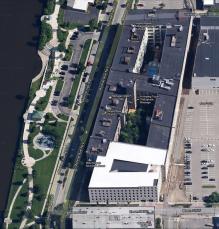
|
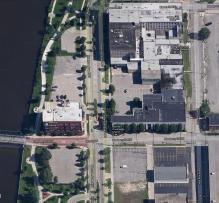
|
Left click on the images below for larger versions.

C&WM furniture car, c1890. |
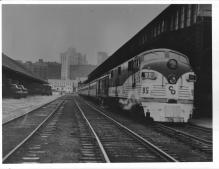
C&O train, Union Depot, track 6, c1945. |

C&O train - Chicago Drive - c1945. |

Left click on the images below for larger versions.
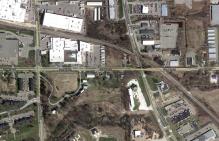
|

|

|
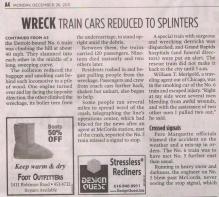
|
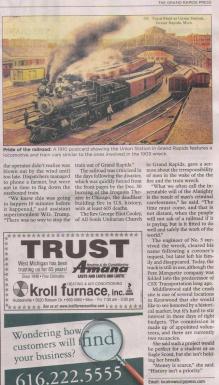
|


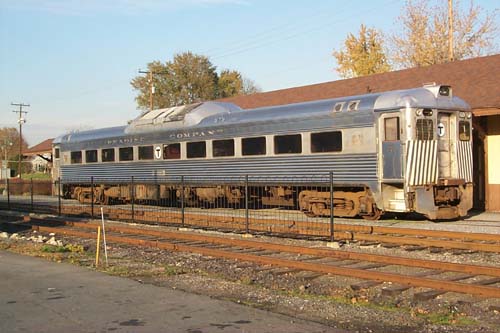
|

|
Budd diesel rail cars looked like a standard passenger train coach, with an observation area, but were self propelled. The Budd Company made a total of 398 of the cars from 1949 to 1956, and they were used in various commuter services, either as single units, or coupled to form trains. They were common in the 1950's and 1960's because the Interstate Commerce Commission forced the railroads to continue to operate many low ridership passenger train routes.
A typical car weighed 110,000 pounds, was about 85 feet long, and had two 250 to 300 horsepower diesel engines. The cars were capable of speeds of around 85 miles per hour. They carried up to 96 passengers.
Left click on the images below for larger versions.
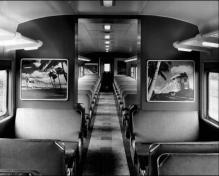
|
One route in the Grand Rapids area started out from the city, then took the track that cuts across Buchanan Street by Plaster Creek, then goes over Division Avenue and 28th Street, the northeast edge of the old airport ( Around 1907 there was a station located there, to serve the county fair grounds ), cutting across Eastern at 36th Street, finally cutting across Kalamazoo Avenue at 44th Street. It then headed out through the corn fields, toward Jackson, stopping at Dutton, Caledonia, Middleville, possibly Irving, Hastings, and a number of other cities further east.
An 1876 map shows that this track was part of the Grand River Valley Railroad. Completed on January 1, 1870, the track ran 84 miles, from Grand Rapids to Jackson. It was soon sold to the Michigan Central RR, and eventually to the NY Central system. Sadly, as of 2003 much of the route is listed as "abandoned." The section from Jackson to Eaton Rapids still functions, and is owned by the Norfolk Southern system. The tracks out of Grand Rapids now end at Kalamazoo and 44th Street, serving as a spur line for the Steelcase plant. Southeast of this the track bed is now a walking path. In some areas there are houses on the old right of way - one day a fuel hungry nation might regret not maintaining the right of ways for possible later use.
In the late fifties I remember seeing one
of the Budd cars at Kalamazoo and 44th Street. It paused there for
a while for some reason - perhaps it picked up a passenger. There
were only a couple of passengers, and apparently the windows could
be opened, like the old streetcars and buses.
Left click on the images below for larger versions.
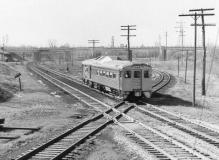
1955 |
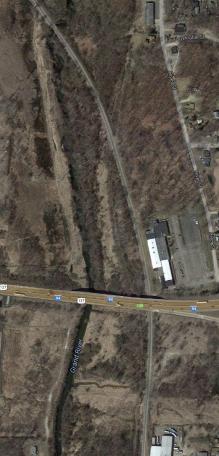
2013 |
When the railroads became deregulated many of the Budd diesel rail cars disappeared. Around the same time the Post Office stopped using trains to carry mail, and many Budd car routes instantly became uneconomic. A number are apparently in storage in different places. A number are operated by historical societies, and like many streetcars that weren't cut up for scrap, some Budd cars continue to operate in South American countries. A rail system in southern NJ, serving the Cape May area, operates today (2003) using Budd cars exclusively.


Frank Rackett, and the rest of the Godwin school board, some time between 1925, when Frank Molesta became a member, and 1929, when the photograph was used in the first annual, "The Acorn." He would have been about 60 to 65 in this picture. Like several others in the photograph, he was a long term school board member, a term of service spanning 1908 to 1947. Perhaps one of Godwin's greatest benefactors, in addition to providing land for the school's expansion, he also recruited Charles Saur in September, 1924, who then went on to see Godwin go from a one room school house to a multi building facility by the time he retired in 1950.
( Provided by Alta May Keiser, class of 1929 ( did not graduate ), who collected the material, Lee (Tanner) Collins, class of 1941, and Joanne Dulyea Hamilton, class of 1951, and the daughter of Alta May Keiser. )

Frank Rackett in an undated photograph. It was used in a newspaper
piece in November, 1933, when he donated his flora and fauna museum
to Godwin. Whether it was a newspaper archive photo, or recently taken
is unclear - he looks different than in the school board photo above,
but whether different means younger or older is unclear. For now, it is
simply November, 1933, or before.
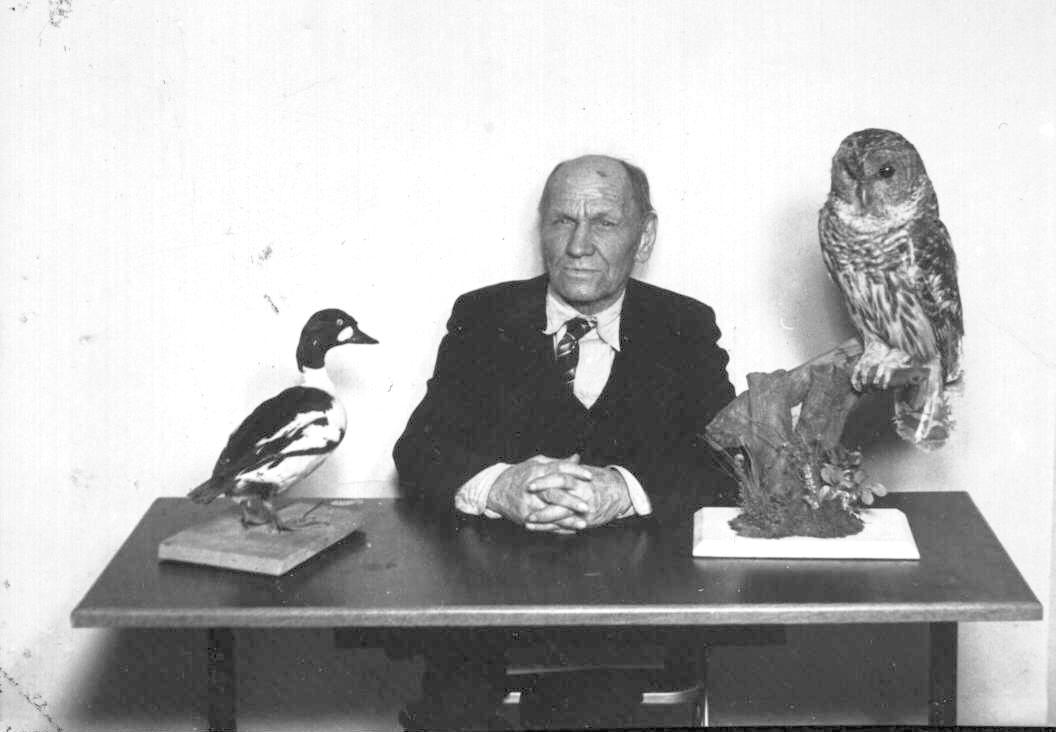
Frank Rackett, in an undated photograph, shown with two of the items from his Michigan flora and fauna museum. A guess would be 1935, or slightly before.
( Photograph supplied by Lee (Tanner) Collins, class of 1941. )
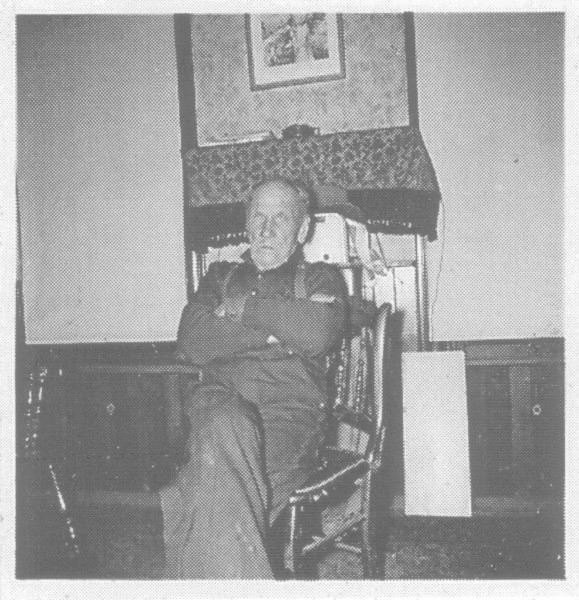
Frank Rackett in the kitchen of his house on the northwest corner of Division Avenue and 36th Street. Who took the picture, why, or when, are all unknown. A guess for the date is about 1935, when he would have been about 71. At this time it's not known what the structure behind him in the photograph was.
Dave Van Dyke supplied the photograph for scanning. He, his father, and his brother, used to visit with Frank Rackett often, including in his kitchen, which seemed to be the primary socializing room. Alas, Dave's father is now gone, and being young at the time, Dave does not remember whether it ever came up where Frank Rackett was from, or any other details of his origins.
Interestingly enough, the picture shown at the top of the photograph,
above Frank Rackett's head, is in the possession of Dave Van Dyke.
Left click on the image below for a larger version.
Access to the picture provided by
Dave Van Dyke, who used to visit Frank Rackett.
Compare the picture above with another instance of the picture
being sold on eBay:
Left click on the image below for a slightly larger version.
It's apparent that the colors are quite different. The suggestion has been made that exposure to light, among other factors, can shift the colors over a period of close to 90 years.
Somehow it does not seem like a picture that would have appealed to Frank Rackett, but then just how the house was furnished, or whether it was, is mostly unknown now.
The art of Bessie Pease Gutmann, 1876-1960, was a fad, peaking in the 1920s and 1930s. Today she would probably be described as a commercial artist, and produced art based on children's themes, apparently inspired by her own three children, between about 1900 and 1947. Prints of her art were presumably widely available, and commonly found in both stores and homes.
In year 2006, a great deal of information about her can be found be entering "bessie pease gutmann" keywords in a Google search. Add the word "biography" to get personal information.
Short Bessie Pease Gutmann biography.
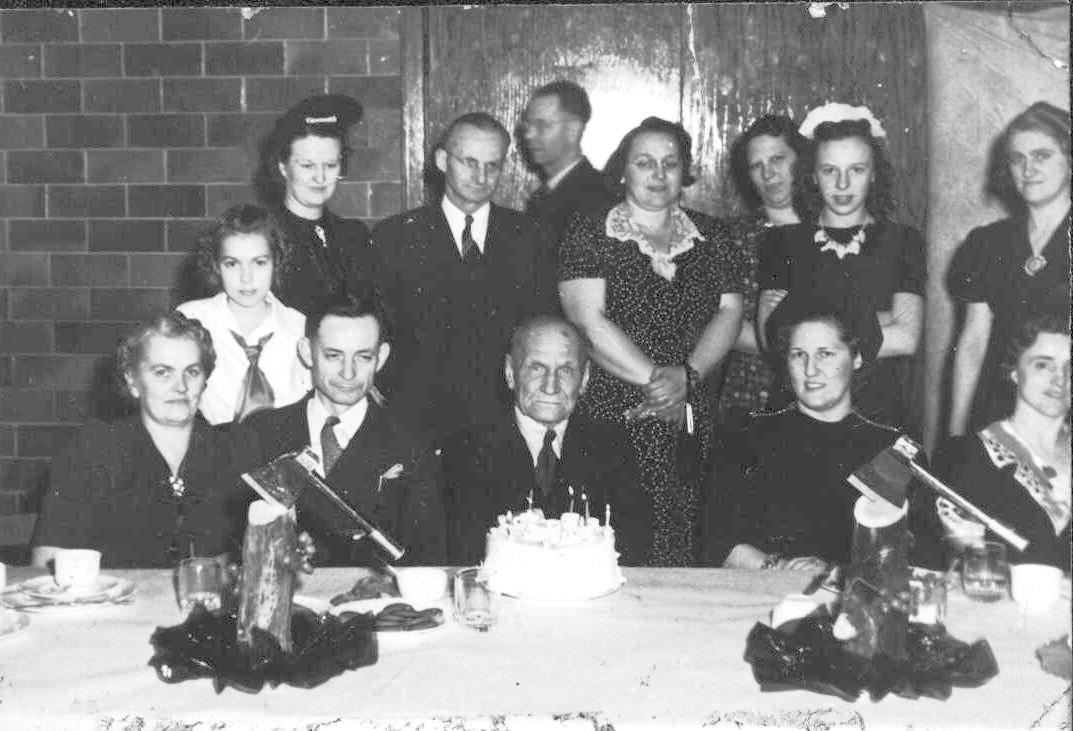
( Photograph supplied by Lee (Tanner) Collins, class of 1941. Names provided by Lee Collins (Tanner) and Lillian Annis, both of the class of 1941.)
A birthday gathering for Frank Rackett, probably taken around 1943. In the front row are Orilla and Jay Doxtator (right behind them is their daughter Jalene, class of 1947), Frank Rackett, and Mabel Garr, class of 1942. In the back row are Arelyne Hopp, in white, class of 1943, Gladys Saur, and the highschool principal. The next three are unknown. Then is Dorothy Van Eerden, class of 1943. It appears the photograph was taken in the highschool.
In year 2007 Jalene (Doxtator) Beattie mentioned that the Campfire Girls did the waiting and cleanup at functions like the one shown, which is why she is in Campfire Girls attire. There would likely have been several people in her group with her tending to the event. This is a tradition that still persists in a sense. At the annual Golden G luncheon, second Saturday of September, students of about the same age tend to serving lunch, coffee, and cleaning up afterwards.
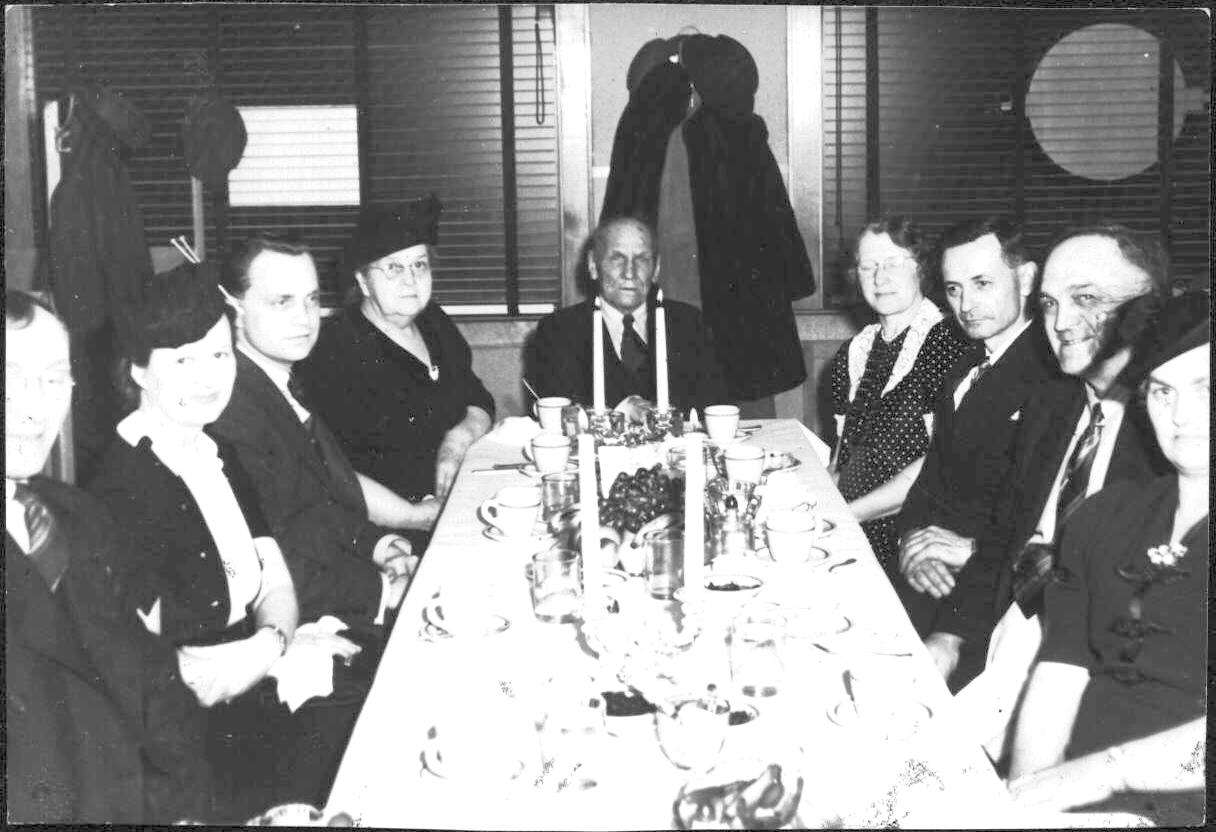
( Photograph supplied by Lee (Tanner) Collins , class of 1941. )
Frank Rackett, in photograph likely taken in 1943 or so. Several possible school board members are present. The person to the left appears to be John Buikema, trustee. Gladys Saur is next to him. Frank Rackett, secretary, is at the end of the table. To his right might be Matilda Andre, trustee. The person third from the right would be Jay Doxtator, president, and the person second from the right would be Frank Bartels, treasurer. The person on the right is Orilla Doxtator, Jay Doxtator's wife. The location is unknown, as is the reason for the event.
Left click on the images below for larger versions.
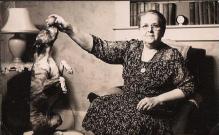
|
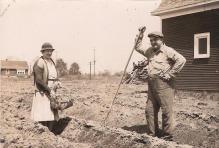
|
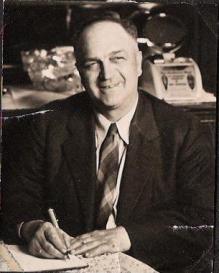
|
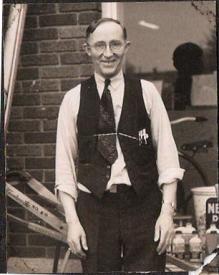
|

|
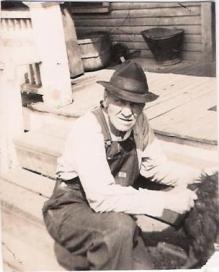
|
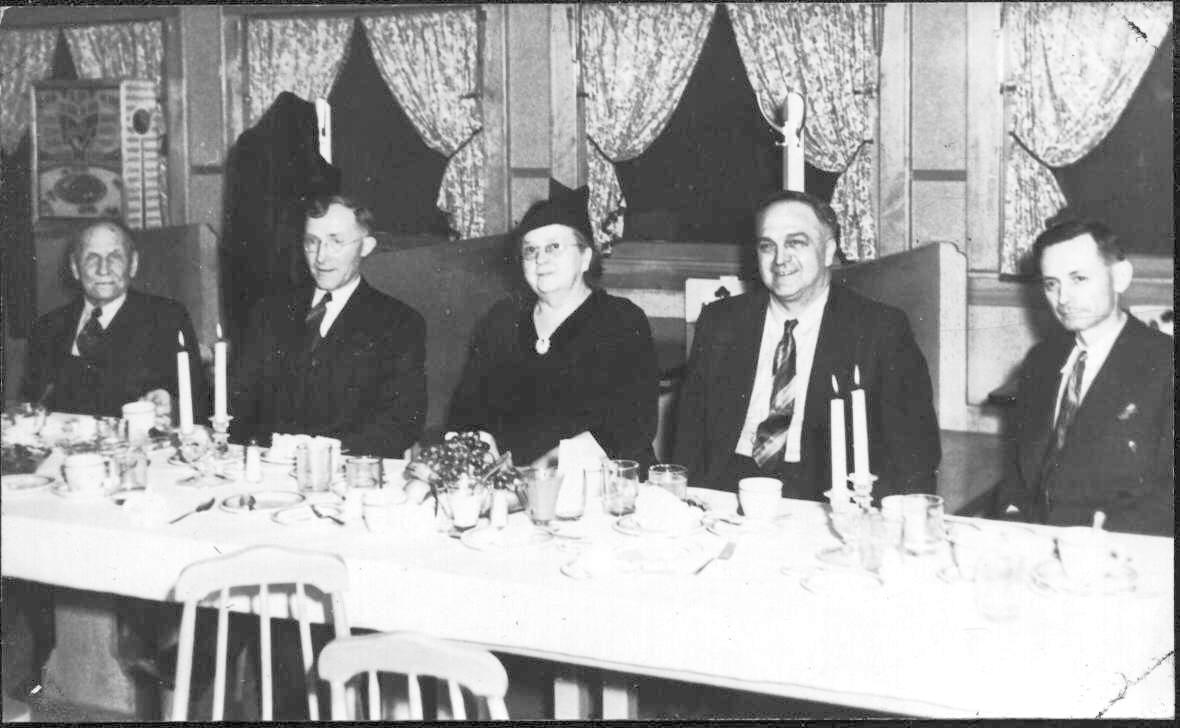
Frank Rackett, in a photograph possibly taken in 1943. It appears to be a school board function, and the people in the photo are the school board. From left to right, Frank Rackett, secretary, John Buikema, trustee, Matilda Andre, trustee, Frank Bartels, treasurer, and Jay Doxtator, president. The location is unknown.
( Photograph supplied by Lee (Tanner) Collins, class of 1941. )
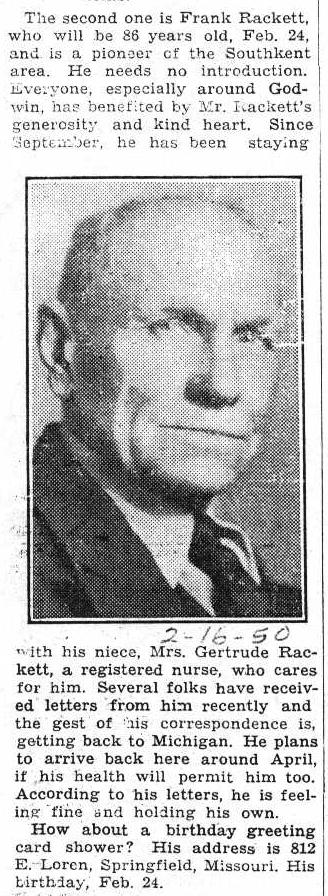
Photograph supplied by Lee (Tanner) Collins, class of 1941.
Frank Rackett in a 1936 photograph, taken on his 72nd birthday. The occasion of the piece appears to have to do with his 86th birthday, in 1950. As of about 1948 he had been living in Springfield, MO, and his house on the corner of 36th and Division Avenue was both abandoned, and, alas, substantially vandalized. He had stipulated that the house be left standing until his death, which was on about September 25, 1957. Almost the day after his death the house was demolished.
The text mentions that the last name of his niece was Rackett, a daughter in law by his brother, George. If anyone participated in the call for cards, or received letters from him, these would be of interest.
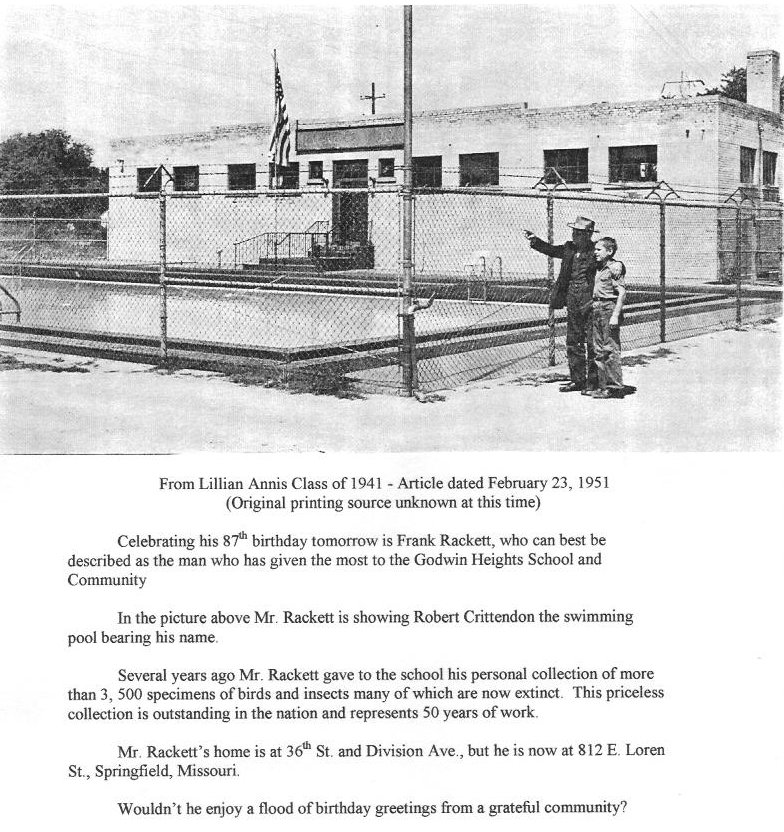
( Photograph supplied by Lee (Tanner) Collins, and collected by Lillian Annis, both of the class of 1941. )
Frank Rackett, in an undated photograph. A guess for the date of the photograph above would be 1938. The pool was built in 1936 or 1937, as part of a large WPA project that included the library building, tunnel under Division Avenue, and the athletic facilities that included tennis courts, a football field with lights, baseball field, and playground. All of this was built on 10 acres of land sold to Godwin in about 1935 by Frank Rackett. It was the the bulk of his farm, and excluded only his house and a lot on the northwest corner of Allen (later 36th) and Division Avenue. Godwin would own that land too.
The item below shows Rackett pool on a summer day in 1961. It was clearly a busy place.
Left click on the image below for a larger version.
Rackett pool building on December 4, 2003. There is no longer a pool, and it's not obvious just what the building is now used for. It's also unclear why the pool was removed. It could have been declining demand, or it could have been rising insurance costs. The large pool in the physical education building is closed in year 2009. While full of water, the current student body does not swim much it seems.
Left click on the image below for a larger version.
Loaned for scanning by LeRoy Rockwell, class of 1959.
From page 4 of a 1951 edition of the Photo Reporter. The photos were taken somewhat before 1951, because Frank Rackett left the area for good in 1948, going to Springfield, MO.
The tern that Frank Rackett is holding is mounted on a light wood base. What has come to light as of an August 17, 2013, trip to the Howard Christensen Nature Center, in Kent, MI, where much of Frank Rackett's collection now resides, is that when the birds and animals were in Frank Rackett's house, they were mounted on bases like this, which were removed when the specimens were moved to the wood boxes built by Godwin shop students in and around 1933. The specimens still on wood bases were apparently those never donated to Godwin. By a process that might never be known, Frank Rackett, or someone else, made provisions for the specimens on wood bases to be stored and preserved. Those at the HCNC are still in very good condition, never having been exposed to vandals. Whether the tern above is at the HCNC, or was taken home by a Godwin staff member is not know at this time.

Frank Rackett, in a dedication picture from the 1945 class annual. He was 82 years old at the time, had served continuously on the school board since 1908, and lived in the white house on the northwest corner of 36th Street and Division Avenue for something like 70 years.
Left click on the images below for larger versions.

|

|
Bob McDonald, class of 1943, has resolved the question of how Frank Rackett came to live at 3579 Division Avenue.
The 10 acres of land, going from Division Avenue west to what would become Buchanan Avenue after it was extended south of Alger, and from Allen Road ( later 36th Street ) to about where Wexford would be if it extended west after crossing Division Avenue, was obtained by the Thomas and Charity Payne family some time between 1876 and 1894, and the white house familiar to decades of Godwin students was constructed, likely by Thomas Payne, who was a carpenter. Asparagus was grown where the tennis courts would later be. In about 1912 or 1913 land was appropriated to build the Grand Rapids to Kalamazoo interurban line. When the interurban went out of business in about 1928 the land was taken over by Consumers Power, and used as a right of way for high voltage lines. In 1935 Frank Rackett's remaining land was sold to the school, for a nominal amount it's said. As a condition of sale, it was specified that he be allowed to live in his house as long as he wanted, and that the house be left standing until his death. While he moved to Springfield, MO, in about 1948, at the age of 84, he apparently always hoped to be able to return to his house at some point. He died in Springfield, MO, on September 25, 1957, at the age of 93, and was living with a niece, Mrs. Gertrude Rackett, at the time. No time was lost in razing the house and other buildings, and erecting a school administration building on the site.
Apparently there was always something doing at the Rackett home, and many Godwin students spent time there doing things. Things like picking asparagus on the land ( the 1930 US census states that Frank Rackett's occupation was "truck farmer." ) where the tennis courts are located today. (It seems that asparagus was a popular thing to grow in the area. Some of the farms just west of the GR & IN railroad tracks by the GM plant also grew asparagus up until at least the early 1950's.) It seems that students would pick the asparagus for one cent a bunch, and Frank Rackett would then sell it for ten cents a bunch. Some things never change.
Frank Rackett was a professional taxidermist. (Charles Saur mentioned that it was a hobby. ) Visitors to the home remember him having significant amounts of arsenic on his hands from his work, and he would proceed to handle and eat things. ( But he did live to be about 95. ) Others have described his living conditions as "worse than a disaster." It seems pretty clear that he devoted himself wholeheartedly to his taxidermy efforts, and his house could fairly be described as a business. But superseding the apparent chaos of his existence were a couple of organized, productive activities. He served for well over 40 years on the Godwin school board, at times as treasurer. And his long term goal was to provide Godwin with a first class flora and fauna museum. He appears to have succeeded at both efforts.
Begun perhaps as early as 1876, when he was 12, some specimens represented in the collection are now extinct. The passenger pigeon for example. Others are at the very least extinct in Michigan, and perhaps more broadly. The timber wolf has probably been gone more than one hundred years. Frank Rackett's specimen, or what has still survived the vandalism of earlier, more unrestricted access to the collection, is an example. As the section below about Frank Rackett's museum shows, the collection had largely gone to rack and ruin as of year 2000, largely because of vandalism, neglect, and a general lack of interest in providing suitable display facilities. As of year 2005 the collection was ten feet from a dumpster.
In the 1930s he brought specimens to grade school classes, and gave noon hour talks as part of regular noon hour activities at the school arranged by a noon hour committee. He also led field trips to the area that was in the 1930s and 1940s known as "Buchanan woods," the wooded area bounded by Buchanan Street on the east side, 32nd Street on the North side, 34th Street on the South side, and the Grand Rapids and Indiana railroad on the west side. A mixture of new and old growth trees, and one of the few wooded areas left anywhere near the Godwin school system, it harbored a rich variety of birds and insects, and would have provided an ideal field study area. It would be interesting to hear from anyone who participated in one of the field trips.
He apparently had global sources of specimens, as indicated by the peacock and some of the exotic moths and butterflies seen in the photo. ( See also the truly huge spiders in the photo which, mercifully, do not seem to be indigenous to the US. ) He apparently stuffed and mounted specimens brought in by hunters who wanted to fill their rooms with preserved animal cadavers, whole or in part - deer heads, fish, etc. He might well have provided specimens to the Grand Rapids Public Museum, although there is no clear evidence of this. Taxidermy was quite popular early in the 20th century, and maybe before this. C. Lindberg's Sport Shop, across from Herpolshimers on the south side of Fulton, was a popular place in the 1930's, and had the stuffed heads of animals from all over the US on its walls. It might have been quite a profitable livelihood.
People who knew him suggest that Frank Rackett was somewhat eccentric. Enough so that it was believable that he would have buried money around his property. Relatives from Missouri took the notion seriously enough to visit the property after he died and dig some holes, apparently never finding anything. The land was also rearranged some when the administration building was constructed. No reports were made of large treasure troves being found. Of course a true believer would say that it was found, and kept by the construction workers, or perhaps buried deeper than anyone has looked, and is still there... Today such rumors could easily invite a robbery.
But the rumor is not entirely out of the realm of possibility. Modern treasure hunters, with metal detectors, will often work the land around and old house or estate, because 75 years and more ago it was indeed common for people to bury money in jars and other things on their land. For various reasons, the money would on occasion be forgotten about, and become the subject of treasure hunters in another era. While there's no reason to believe that he buried it, Frank Rackett apparently did have a substantial coin collection. Not given to the school, it is not clear just what happened to it. A collector with wide interests, he also had a collection of indian relics, and sea shells. What become of them is also unknown. Hopefully the material went to a museum or institution able to adequately take care of it.
Mrs. Dorrit (Torngren) Foltice, class of 1945, related that area PTA women took Frank Rackett under wing in the 1930s and provided support when, for example, he needed a place to stay after an operation. She mentioned that he needed some money for something on one occasion and said he'd "be right back." He returned with a cigar box "that had dirt on it." It does appear that he did bury money around his house, odd as that seems in year 2005. In the 1930s people didn't trust banks much, in keeping with the effects of the Great Depression. Many alum claim that he also stashed money around the house, and would been seen locating some when the occasion warranted. While strange sounding today, it's likely that many people did similar things. With reasonable discretion, the risks were probably minimal in an era of tighter knit neighborhoods, and a more trusting world in general. And for most people in the Godwin area during the 1930s banking was largely a matter of getting a home mortgage, and perhaps cashing one's paycheck. It's likely that people generally did not have a lot of contact with banks otherwise. Small businesses used checks. Many people probably paid in cash.
Left click on the images below for larger versions.

|
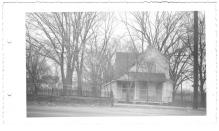
|
Does anyone have any other photographs of the house and other buildings?
Just when the white house that Frank Rackett's family owned was built is not exactly known just now, but land records likely do exist which could resolve this. A best guess for now is some time after 1876, because the Payne's did not own the land at that time. The layout of the two story structure appears to have been as follows: a partial cellar, a first floor consisting of a storage area on the west end, followed by a kitchen and dinning area, and some kind of living room, bedroom arrangement. There was a second floor, of which it's been said "God only knows what was up there." It is likely the upstairs rooms were originally bedrooms.
The architecture of the house suggests an old farm house. But this could be misleading, because Thomas Payne was apparently a carpenter. So the house is more than likely just a simple period structure. Cellars in the 1800's were often known as root cellars, where root meant something like potatoes, and anything else that had to be kept moderately cool and dry. The cellars often had dirt floors, stone walls, and didn't resemble the modern concept of a concrete or concrete block basement. The kitchen-pantry arrangement also suggests an 1800's architecture.
Left click on either item below for larger versions.
The item above was apparently part of a 1966 attempt to write a book about Godwin, perhaps as a centennial project. Who wrote it is not known at present. The statement that Frank Rackett started to donate his collection to the school in 1927 should probably read 1937, when the library was finished, but this is not certain. He might have been donating specimens to the building on Division Avenue as early as 1927.
If he did indeed start the flora and fauna collection at age 12, that would be 1876, more or less when the family moved to the house on the northwest corner of Division Avenue and 36th Street, and in year 2006 the remnants of the collection would be 130 years old. Bureaucracy being what it is, it will likely not become known just who decided to trash the collection, and much of the rest of Godwin's history, but it is a sad loss to future generations of Godwin student, and an act that cannot now be undone.
There's reason to believe that when Frank Rackett went to Springfield, MO, to live with a niece, Gertrude Rackett, he just locked the door at his house at 3579 Division Avenue and left. Little to nothing was packed and moved with him. This was in 1948, and he was 84.
Left click on the image below for a larger version.
812 E. Loren Street, Springfield, MO,
where Frank Rackett spent his last 11 years.
GPS: 37.193569 -93.284154
Left click on the image below for a larger version.
The item above is from the Grand Rapids Herald, September 25, 1957, page 17, and was obtained by Tammy Beattie, class of 1966.
Dave Van Dyke does say that Frank Rackett apparently did leave the house for extended periods in his later years and returned. Dave remembers his family picking Frank Rackett up at what he believes was Union Depot. Frank Rackett apparently never did have a vehicle. So for a while, perhaps his final departure simply looked like another extended vacation.
As often happens with houses not in use, the local vandals wasted little time breaking in and destroying the inside of Frank Rackett's house, as well as the contents, as the image below shows. Just how and when the photograph was obtained is not clear. It was in the possession of Dave Van Dyke's father, who knew Frank Rackett well. Whether the doors to Frank Rackett's house were broken open, and the photograph made, or just what the circumstance were, it is mildly incredible that the photo exists. Frank Rackett left his house some time in 1948, and died in 1957, so the photo was made time in between these two dates.
Left click on the image below for a much larger version.
The photograph was made available for scanning by Dave Van Dyke.
The results of the vandal's mindless rampage through the kitchen area of the house confirm that psychopaths exist in every generation. One can see cups, pots, pans, drawers, books, newspapers, and perhaps pictures strewn about, all lending credence to the notion that Frank Rackett just left his house as though he was leaving for a vacation. It's tempting to wonder now whether family photographs and other family history were part of the belongings trashed by the depraved actions of those seeking perverse thrills. Mrs. Harriet Richards, a long time teacher at Godwin, and resident of Cutlerville, remembered seeing a card in 1941 announcing a Christmas Ball at the Godwin House (Hotel). The Godwin House, built in 1865, and burning in 1871, hosted a number of upscale local events. How Frank Rackett came to own the card is not known, but this indicates the kinds of things that might have been in the house if anyone took the care to look. Sadly, Frank Rackett never did get back to the house. Technically private property, no one would have had the legal right to go through his things. But it's also regrettable that he did not indicate to someone what should be done with some of his more valuable belongings - photos, documents, collectibles, etc. It will probably never be known in detail now what Frank Rackett left in his house when he left for Springfield, but one can speculate that some of it would have been of great historical interest today. And of course many of the things in his house were antiques by the time he moved out.
Rose Russo, class of 1953, relates the following: "I entered Godwin in 1944 and I met Frank Rackett one year at his house/museum maybe around 1947-1948, and it was absolutely packed to the gills with stuffed animals, pictures, books, you name it!! That was his house and he was living there at the time. He seemed friendly enough but seriously busy with something or other. I don't recall why I had the opportunity to go with several friends, but it was a bit 'spooky' to me, it was so dark and cluttered! I'm glad now that I had that opportunity."
There can be little doubt that Frank Rackett's house contained a great deal of material that would have had incredible historical interest in year 2007.
LeRoy Rockwell, class of 1959, mentions that an 8mm film was made of the inside of Frank Rackett's house as part of some kind of Halloween prank. The house was to be the haunted house for the "film." Others have mentioned this too. It seems that up to five years ago the film still existed, and LeRoy is endeavoring to find it. If anyone has it, it would be of interest to get some of the frames converted to photos, before the film deteriorates too much. If anyone else has material from the house that would be of interest for the web site, it is hoped that they will come forward also. One can never be sure what still survives somewhere, but the chance to put it in context might be waning. Gertrude Rackett, the niece that Frank Rackett went to live with in 1948, died in about 1975. And grand nieces or nephews would themselves be in their 70s or 80s now.
LeRoy remarks that the house was repeatedly broken in to. Someone would put a lock on the front door, and the vandals would simply break in again. For the most part, essentially anyone could simply walk in to the house between 1948 and 1957, and no doubt just about anyone did. Inside the house himself, LeRoy remarks that there was "stuff" everywhere in the bottom rooms, except for the kitchen area, which Frank Rackett used to entertain any number of visitors, including Godwin students and staff. It was apparently the only room in the house free enough of clutter to permit such activities. The "stuff" included stuffed animals not given to the school, and papers of all kinds. He was the consummate collector. It's likely the upstairs rooms contained endless stuff too, but this is not actually known now.
As one can see below, the flora and fauna collection that Frank Rackett spent something like 50 years constructing was, as of December, 2005, just trash, sitting in a janitor's storage area - the women's shower area of the old gym - waiting to be thrown out. It is totally smashed, and covered with dust and dirt. It is ironic that the legacy of someone who did so much for Godwin has been shown so much contempt. It's fair to say that the school itself owes a great deal to the actions of Frank Rackett, and yet in year 2006, his presence at Godwin is ghostly at best.

Maple Park Cemetery, Springfield, MO
Photographs supplied by Lee (Tanner) Collins, class of 1941, and Dave Van Dyke. Material about Frank Rackett supplied by Lee Neugent and Lee (Tanner) Collins, Ron Torngren, class of 1953, Dick Speas, class of 1948, Lewis Lull, class of 1940, Edna (Carpenter) Keyes, class of 1934, Forrest Keyes, class of 1932, LeRoy Rockwell, class of 1959, and Dorrit (Torngren) Foltice, class of 1945.

Donation of a flora and fauna collection to Godwin.

The image above is from the 1938 class annual. When it was taken is not clear.
Sadly, almost every bird and mammal in Frank Rackett's fauna collection started out just as the bobcat above did - at the losing end of a gun. It's possible that Frank Rackett obtained some of the specimens from international sources, but many he harvested himself. In the 1870s, when he possibly started the collection, wildlife was still abundant all over Michigan. Relentless shooting and "development" make it likely that most of the animals are essentially extinct in the area now. It's simply a different world today than the one of the 1870s.
The bobcat shown above is quite possibly the one in the flora and fauna collection.

Material provided by Lee (Tanner) Collins, class of 1941.
A 1938 photograph taken in the Frank Rackett flora and fauna museum, probably housed in the northwest corner room of the new library building, ground floor, shows a meeting of perhaps the Campfire Girls. Lee Tanner, class of 1941, is shown at bottom right. Above her is Evelyn Hills. A more touchy society would likely make an activity like this impossible in 2004. Scouting and other outdoors oriented groups were declared militaristic in the Vietnam era. Coupled with an almost total lack of open space around Godwin by the 1960s, scouting activities were mostly gone. By year 2004 picnics and even backyard barbecues are largely gone, victims of all manner of social change.
It can be seen from the pieces below that Frank Rackett's flora and fauna museum was never taken very seriously by the school. After it was donated to the school in 1933, ( Accounts vary as to just how it was donated - all at once, or a little at a time, and just when the donation began. ) open access to the specimens resulted in substantial vandalism, and subsequent restricted access. The collection was originally housed on the second floor of the Division Avenue school building, and perhaps in 1938 moved to the center room in the basement of the library building closest to 36th Street. It was still there in 1973, but apparently moved somewhere after that. All evidence in 2004 is that the collection has largely fallen into ruin. Why an inventory was never done when the collection was new is unclear, as is a seeming lack of even photographs. It more or less states below that much of the collection has already been discarded, and some of the rest is in very poor condition. Collections such as this are usually considered delicate, and would be housed in a stable environment. Sadly, it might have been better if Frank Rackett had donated a life's work to an institution that could have properly housed and appreciated it. Alas, it's mostly gone now, and it's likely that no one even knows what was there.
From the Godwin News September 30, 1938
`MUSEUM BOASTS 1200 SPECIMENS
Looking back into the history of this community, we find one of Godwin's most interesting citizens in Mr. Frank Rackett, a man content to live on the outskirts of the city's bustle and let, "the rest of the world roll by." Most of his life has been spent with nature, although he was trained for something far different. His love for nature drew him out to the outskirts of Grand Rapids where he has resided for many years enjoying to the full his life work. Much does the school owe to him in thanks for he has played a large part in placing on our grounds one of the finest natural science museums to be found. In this museum there are 1200 specimens of which 550 are birds, 50 are mammals, 450 are insects, and 150 are beautiful shells and coral. Two hundred and eighteen of the birds are either migratory or permanent residents of Michigan.
Mr. Rackett's aim is to complete his collection of every species of foul and mammal in Michigan. He would like, if he had adequate space, to put all the big game of the West and Michigan in the school museum so that people would come to Godwin School for reference instead of going to Ann Arbor or Chicago or some other big city.
He also has a collection of hundreds of butterflies and insects from all over the world, which he has no room to exhibit. Mr. Rackett's favorite collections are his coins and Indian relics, which he does not care to put in the school museum because of the lack of security.
Let us hope that in the future adequate space is given Mr. Rackett to do as he would like, and to incorporate those larger animals into this collection which has for many years been of great value in teaching the members of this community the secrets of the out-of-doors and in helping to put Godwin on the map.
Material provided by Lee (Tanner) Collins, class of 1941.
Note: The piece refers to Frank Rackett having been trained for something "far different" than spending his time with nature. Does anyone know what kind of training? It seems reasonable to assume that he was a professional taxidermist, but if not, what?
The piece also refers to a coin and indian artifact collection. Does anyone know any more about this? There is concern at the moment as to just where Frank Rackett's flora and fauna museum is, or who is in control of it. Moreover, it's not clear that an inventory is available, or was ever done, so just what might have existed and is now missing for some reason is additionally unclear.
The following images, from 1963, show a few aspects of the Frank Rackett flora and fauna collection when it was more or less safely housed in the basement of the library of the time, probably in the south end room.
In one photograph teacher J.B.Ward is holding one of the bird specimen cases. He had been around Godwin long enough at the time to have known Frank Rackett. The text next to his picture refers to Frank Rackett as Harold Rackett. This seems like a mistake that J.B.Ward might have caught. Or is it a mistake?
Left click on any image for a larger version.

|

|
( Material provided by Lee (Tanner) Collins, class of 1941. )

( Material provided by Lee (Tanner) Collins, class of 1941. )
The last paragraph of the piece shown above pretty much sums up the tragedy of Frank Rackett's flora and fauna collection. Donated almost 60 years ago, vandalized, neglected, and largely discarded, it's truly hard to see how the collection is getting closer to realizing its original intent. Indeed, with this kind of progress there will be little to nothing left of the collection in not so many more years. Instead, this is a sad testimony to the lack of respect given a significant Godwin benefactor, and to an irreplaceable project almost 50 years in the making.
Click here to see the result of Matt Hoezee's effort to inventory the collection in 2002. About 425 items are listed. Of those, the location of 109 is listed as "unknown," and the identification for 29 others is missing. A 1938 piece, shown above, says there were 1,200 items in the collection. In addition there were also "hundreds" of butterflies and insects from all over the world. No mention of the "150" shells and coral is made in the current inventory. Many of the missing items are insects, which are very delicate when they get old and dry. If the international butterflies and insects were donated, those might well have disappeared also. It appears that the bird cases have survived the best, although the condition of the birds inside is unknown.
It's not clear that a complete inventory of the collection was made or available when Frank Rackett donated the collection. So just what was once there will likely never be known now.

The item above is from the first page of the October 26, 1956, issue of "The Wolverine." Just where the figure $70,000 came from is not clear. Perhaps the museum was actually appraised. Assuming for a moment that the figure is roughly correct, the figure in year 2006 might well be ten times that, or $700,000, based on 50 years of inflation, and what has happened to worker salaries. Of course the collection might even be more valuable today, because many of the specimens come from birds and animals that are extinct in year 2006. The collection includes a passenger pigeon, for example, extinct since 1914, when the last specimen died. ( The last one in the wild was spotted by a kid with a gun, and immediately shot. In about 1900. )

|

|
Martha, the last passenger pigeon, died September 1, 1914, in the Cincinnati, OH, zoo.
Left click on the images below for larger versions.
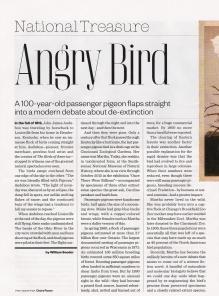
|
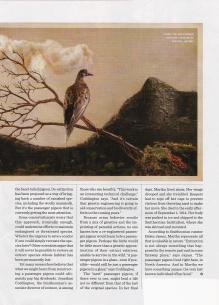
|
The grim reality of Frank Rackett's flora and fauna collection in 2005 is shown below.
Left click on any image for a much larger version.
|
|
|
|
|
||||
|
|
|
|
|
The images above were taken in what was once the women's shower room in the old highschool. Now a storage area for custodial work, Frank Rackett's collection is stacked like garbage. A life's work, started as much as 130 years ago (1876), and given to Godwin school by Frank Rackett in 1935, is now just dust covered debris. Today there is very little sense of history at Godwin, and apparently no one in a position of authority has the time or interest to care. What was a world class collection of Michigan flora and fauna is now but one simple decision from ending up in a large blue dumpster that sits just outside the door that the wolf seems to be staring at, as if viewing its own fate. If space is needed for more paper towels or other supplies, the entire collection could disappear in a day. And likely will.
The bobcat, said to be Frank Rackett's favorite item, was not seen. Someone managed to finally tear the ears off the wolf, consistent with a pattern of vandalism dating almost to the day the collection appeared at Godwin. The collection never was given a proper displays area, and specimens that were in the open were subject to the destructive impulses of weak minds. The collection should have been donated to the Grand Rapids Museum, or some other institution that would properly house and maintain it.
Some of the specimens are irreplaceable. Notice, for example, the display of crows - the image at the right side of the top row. One of them is white. And it's not an albino, because it would not have survived. Nowhere in the world do pure white crows exist in any numbers. A species in Africa is white and black. All North American species of crow and ravens are pure black in general, so the pure white one was a rare find indeed, and of course had to be shot to become part of the collection, as all rare animals are shot for one reason or another. Hopefully at some point in time animals will only be shot using cameras, but in the world of 100 years ago to find an animal was often as not to kill it.
For a Godwin student of 50 years or more ago the images above are likely to be disturbing. They represent an almost complete break with the past that any of the older students knew, and of course a loss of the history of the community. To the extent possible, these are the things that this web site endeavors to prevent.
Left click on the images below for larger versions.
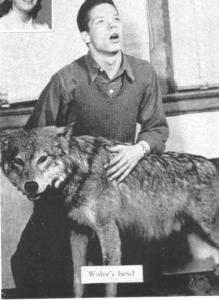
1945 |

June, 2008 |
Left, above, shows what Frank Rackett's wolf specimen looked like in 1945, before vandals went to work on it. A June, 2008, photograph of the room containing what's left of Frank Rackett's flora and fauna collection. The cases are stacked somewhat differently, and for whatever reason have not been put into a dumpster. The highly vandalized wolf has of course not moved. Guard dog, or just watching for the dumpster?
In July of 2012 a number of the cases in Frank Rackett's collection showed up
at the Howard Christensen Nature Center, just north of Kent City, Michigan.
A volunteer has done a heroic job of restoring specimens, and fixing or
replacing damaged boxes. It's said that the subset of the collection contains about
400 birds, which would include multiple birds in one case.
Left click on the images below for larger versions.
Left click on the images below for larger versions.
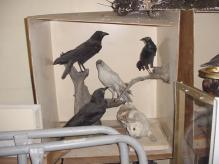
2005 |
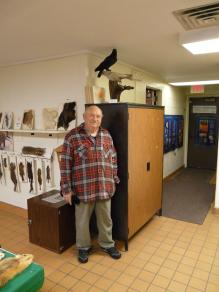
2013 |
Left click on the images below for larger versions.
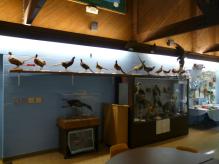
Game birds. |

Water birds. |
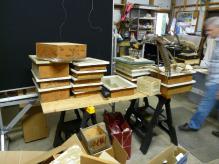
Awaiting repair. |
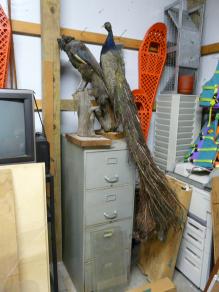
Peacocks - need feathers, a head, etc. At left is apparently a female. |
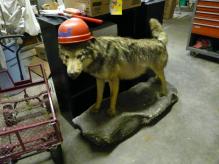
Lobo needs ears |

The Rogers school district was formed in 1916, and a school built in 1917 on the southeast corner of what is now 28th Street and Clyde Park. This burned down in 1922 (apparently arson), and was replaced by a six room brick structure. In 1929 a second, much larger building was added, at the same time as the new Godwin high school building, and now doubt also reflecting the explosive growth of the area. But even in to the mid 1940s Rogers school was still small enough that one could essentially know everyone.
Left click on the image below for a larger version.
The annual was called "The Rocket," an interesting name in 1946. In 1946 yet Rogers school only went to the tenth grade. ( Godwin made the switch to a full 12 grades in 1925, and the first 12 year graduating class was 1927. ) Apparently the area around the school had not developed a lot before WWII, after which it seems to have boomed. ( Rogers school contributed its share of WWII military persons, and suffered its share of casualties. There was a marker in the area of the school listing them, shown in a newspaper clipping below. It has been moved to the site of the new highschool. ) For example, the land west of Michael Avenue, near 32nd Street, was still unused farm land in the early 1950s yet. East of Michael, 32nd was being built up in around 1954. Much of the land along 28th Street, between Michael Avenue and Clyde Park Avenue was still open land in the early 1950s, except for a "Town Talk" gas station ( apparently called Tuft's in 1946 ) on the southwest corner of 28th Street and Clyde Park Avenue, once the site of the original Rogers' family home. ( For some reason, it was moved to what is today just northeast of the corner of Prairie Parkway and Michael Avenue. Just when is not clear. )
It's similarly the case that areas around Godwin that were still farm land and open fields were all filled in with housing plats about the same time. Land east of the old airport, and the area that was once called Buchanan woods, developed rapidly in the early 1950s.
In 1946 the tenth grade class was still only 18 students. Not enough to fill even one class, apparently it was still considered adequate to have those students wish to finish all 12 grades go to other schools, just as students from Godwin did before 1925. Some of the schools that could be chosen include Godwin, Kellogsville, and Wyoming. What the transportation arrangements were are not clear, but people at the time were not afraid to walk or ride bikes. Godwin, and possibly Wyoming, were within walking or bike riding distance. Kellogsville must have involved taking the Division Avenue bus, although more hardy students could have used the Grand Rapids and Indiana railroad tracks. It was a day in which schoolbuses were a rarity, and students were more robust. Ronald Belknap and William McCarthy went to Godwin in 1946, and Janice Waxman and Marty Wright, from other years, all to finish grades 9 through 12.
The six room school house on the corner of 28th Street and Clyde Park,
which housed grades 4, 5, and 6 in 1946,
was demolished in 1958. The larger building has not been used as a school
for some time, and has housed various other community activities recently.
In 1997 it was sold, and at that time its fate was unclear.
In year 2006 Rogers Highschool is located on the south side of Prairie
Parkway, about two blocks west of Michael Avenue, and in terms of physical
plant is a complete break with the past.
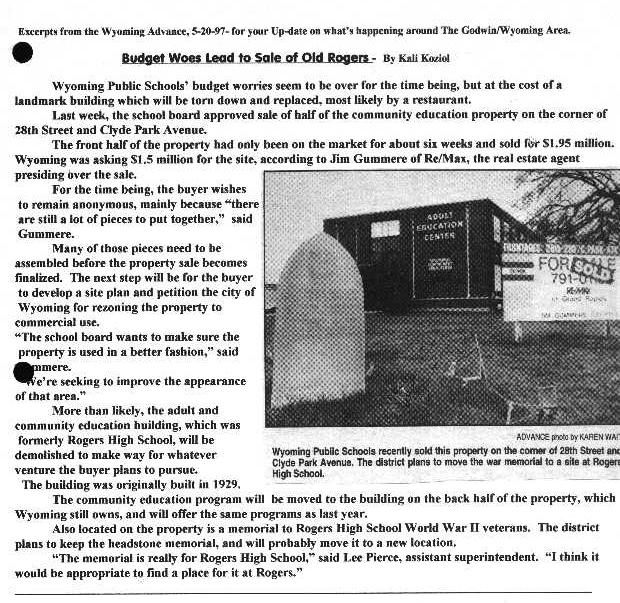
Material supplied by Lee (Tanner) Collins, class of 1941, and Bob Sloan, class of 1948.
Left click on the image below for a larger version.
Town Talk station on the southwest corner of 28th Street and Clyde Park Avenue, circa 1946.
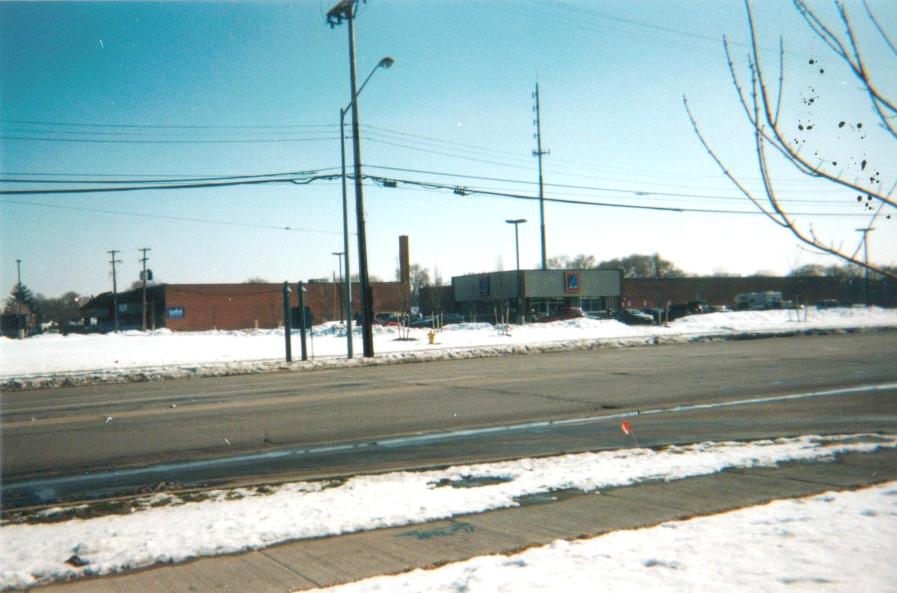

Godwin students in the 1920s, and through the entire 1940s, were familiar with the frequent trains on the Grand Rapids and Indiana tracks which parallel US 131 south out of Grand Rapids, and those on the old NY Central tracks which ran along the northeast edge of the old airport. From 1915 to 1928 there was an interurban line that cut mid way through Frank Rackett's property, and is now the site of high voltage transmission lines belong to the old Consumers Power Company.
Union Station was last built in 1900, and razed in 1960 to provide space for US 131. Located on Ionia Avenue and about Bartlett Street, Most Godwin students from the early 1950s and back will likely remember at least one train trip starting at Union Station. Into the mid 1960s the C&O railroad had passenger service into Grand Rapids, and its blue and yellow color scheme was distinctive. In 2004 the C&O railroad is also but a memory.
Other stations in the area included one in Grandville, Lamar station, north of Chicago Drive, and Fisher station, at 54th street. (These provided by Craig L. Lull, class of 1970. ) On the NY Central track, originally called the Grand River Valley railroad when completed on January 1, 1870, and later owned by the Michigan Central system, there were depots at the Kent county fair grounds (later the Kent county airport ) and at Bowen Station, apparently on the southwest corner of 44th Street and Kalamazoo. The latter existed into the mid 1950s. In 2004 all of these stations are but memories.

left click on either image below for a larger version.
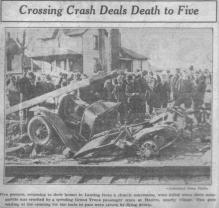
|
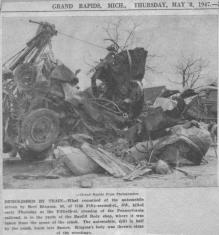
May 8, 1947 |

|
Collisions between cars and trains, and trucks and trains, was relatively common in the 1940s and before, and inevitably fatal. It was still a time when trains could and did go fast. Many rural road crossings were marked, but did not include signals. Complacency could be deadly. And the train always won.
The roads were generally less congested, leading people to speed. A surprising number of Godwin students were killed over the years as a result

Left click on the image below for a larger version.
Above, Thomas E. Reed, one of the founders of East Grand Rapids in 1891. The Reed family came from New York, and settled in the Reed's Lake area in the 1830s. Like many early settlers, their land became valuable. The lake became a popular recreational area by the middle 1870s, and was served by the Grand Rapids and Reeds Lake Railway, on Sherman Street. Eventually trolleys, and then buses, served the area, as well as an interurban, which brought people in from other cities, although that might mean as far as Grand Rapids, after which a trolley or bus would be taken to the lake.
Left click on the images below for larger versions.
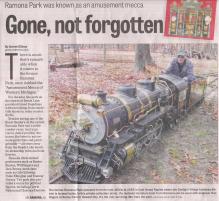
|

|
Left click on the images below for larger versions.
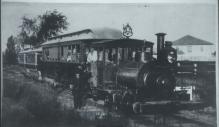
c1880 |

c1880 |

|
Left click on the images below for larger versions.
Left click on the images below for larger versions.
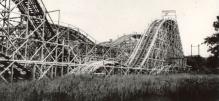
"Jack Rabbit" - 1914 |
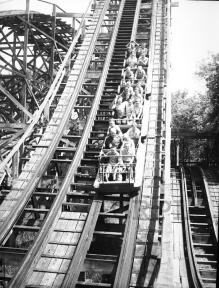
Newboys picnic - June 23, 1945 |
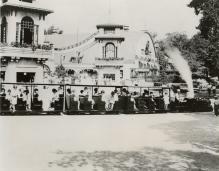
|

Gardens pavilion |
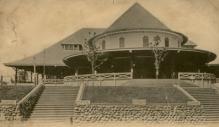
Theater pavilion |
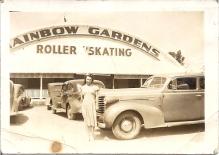
Circa 1945 |

Left click on the images below for larger versions.

|
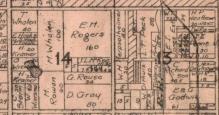
|
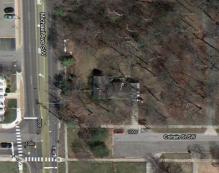
|
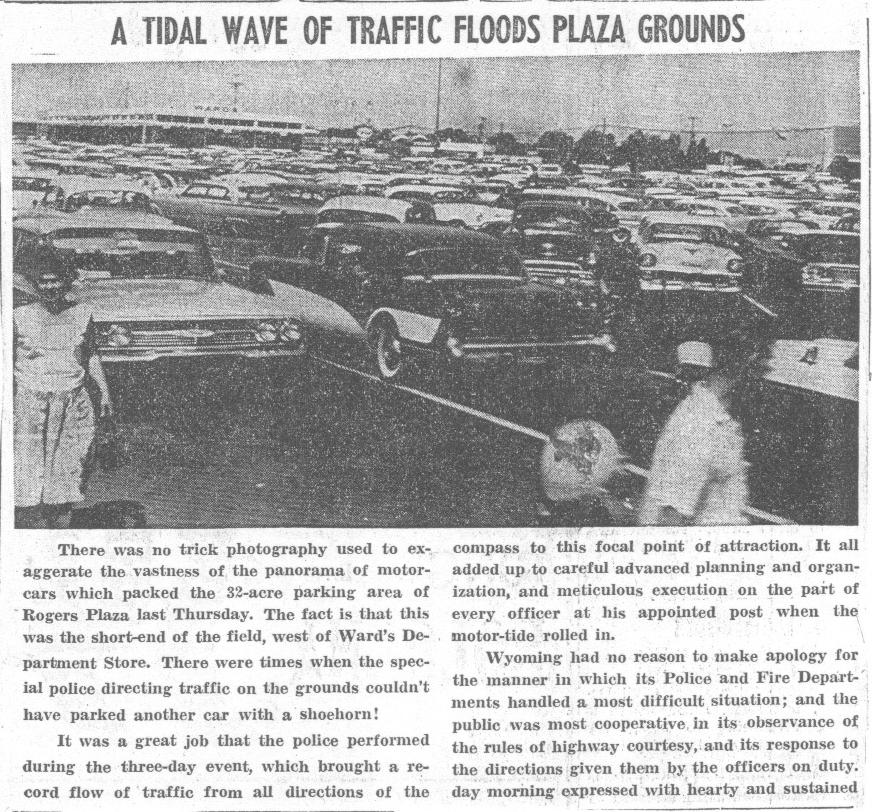
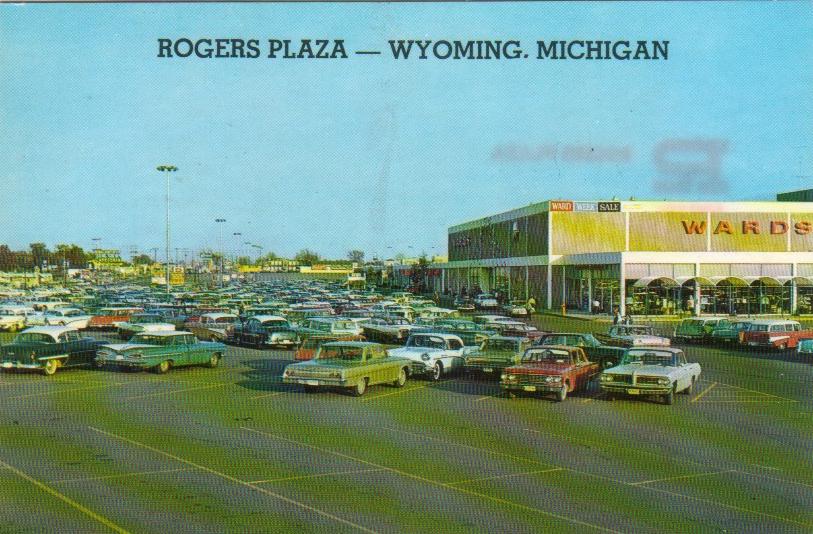

The following photographs show Rogers Plaza in the process of being razed
after about 40 years.
Malls seem to have a short lifetime anywhere in 2005.
The public seems to have lost interest in the format.
The anchor store, Wards,
had fallen on hard times. Once Montgomery Wards was a strong competitor to
Sears, but the Wards chain failed to keep up with changing trends. It was
briefly owned by Mobil Oil, which is now part of Exxon Mobil. In general the
mall simply lost market appeal.




Material supplied by Lee (Tanner) Collins, class of 1941.

